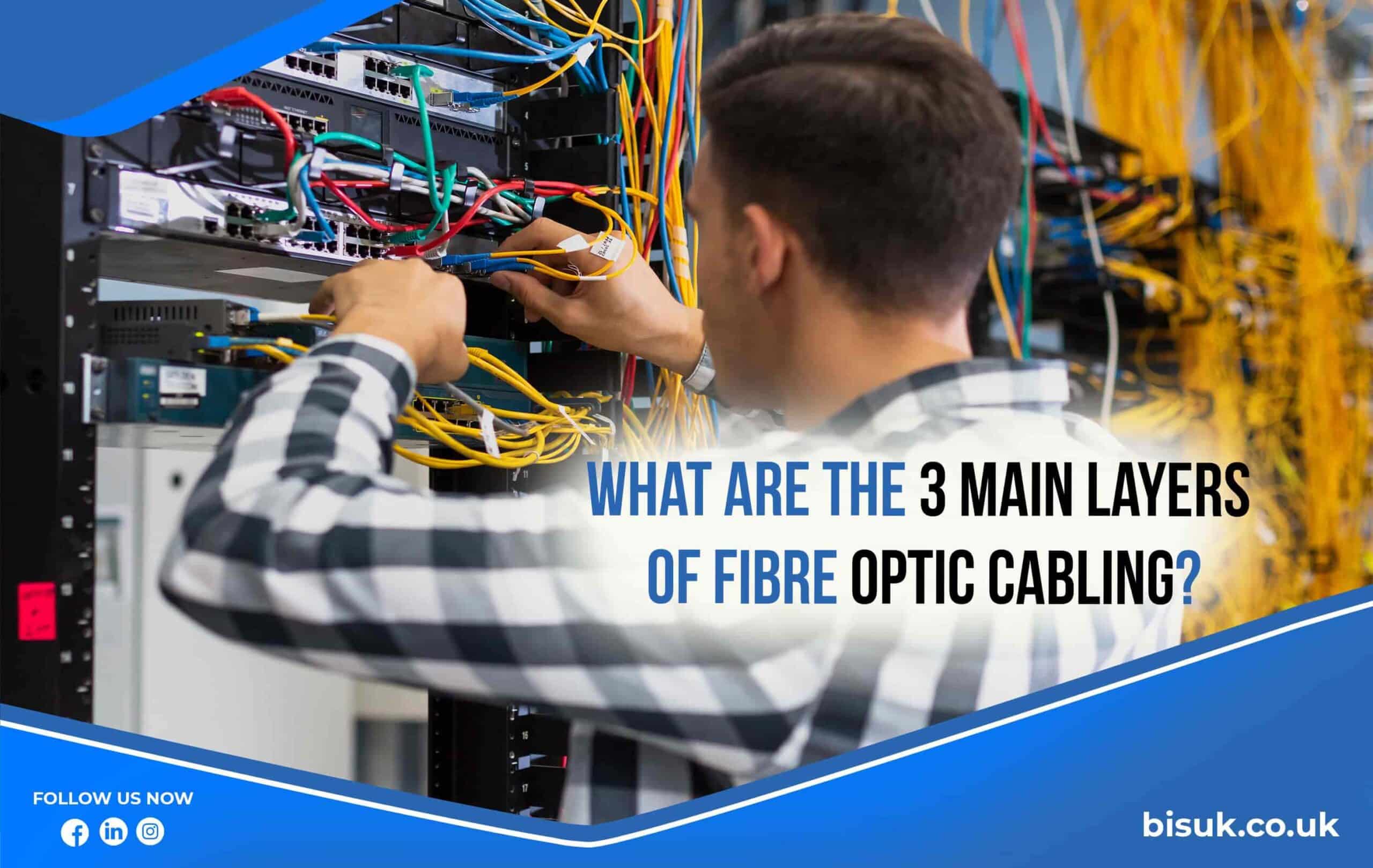Dealing with a tangled mess of cables can be a nightmare for businesses and IT professionals alike. Structured cabling, based on the ANSI/TIA-568 standard, streamlines this chaos into an organized system.
This article breaks down the six essential components you need to know to tame your tech tangle and enhance your network’s performance. Discover how clarity in cabling can transform frustration into efficiency—keep reading!
Key Takeaways
- Structured cabling has six main parts: Entrance Facilities, Equipment Room, Backbone Cabling, Telecommunications Room, Horizontal Cabling, and Work Area. Each part links together to form a strong network.
- Following ANSI/TIA – 568 standards is crucial for setting up and running structured cabling systems the right way.
- A well – designed system can cut costs and downtime while allowing room to grow with new tech needs.
- High – quality installation and regular testing are key to avoid problems in data flow through the cables.
- Proper planning of a structured cabling system helps cope with future tech changes and keeps networks working fast.
Understanding Structured Cabling

Structured cabling forms the backbone of any reliable network infrastructure. Think of it like the highways that keep traffic flowing in a big city. Cables run from different parts of a building, connecting phones, computers, and machines to the world outside.
These connections start at the entrance facilities, where service providers link to a building’s network.
Within these walls lie pathways and spaces for copper wires or fiber optic cables. They travel through an equipment room containing servers and switches – essential gears that manage data flow.
From here, backbone cabling takes over as major corridors linking different areas in the structure. Horizontal cables then branch out like streets leading to various offices and cubicles – what we call work areas.
This whole network must follow strict rules known as ANSI/TIA-568 standards for proper setup and functioning. Installers use patch panels and patch cords for flexible connections within the telecommunications room (TR).
Every cable must be carefully placed to avoid interference with signals – no shortcuts allowed! Properly managing this complex system ensures smooth communication today and easy upgrades for tomorrow’s tech advancements.
The Six Components of a Structured Cabling System

Diving into the world of structured cabling, six key components emerge as the building blocks that ensure a cohesive and efficient network framework. From where services enter your building to the very devices users interact with, each piece plays a crucial role in enabling seamless data flow and communication.
Entrance Facilities
Entrance Facilities act as the gateway where a building or campus receives telecommunication services. This is the spot on the wall where cables from outside, like copper cables or optical fiber, come into play.
It’s vital to shield these incoming lines with protective devices. This helps keep things safe when they connect with either external service providers or a private network’s cabling.
These facilities are crucial in structured cabling systems and follow strict ANSI/TIA-568-C.0 and ANSI/TIA-568-C.1 standards for installation and function. Experts use these guidelines to create networks that are easy to manage and fix if something goes wrong.
Reliable suppliers provide useful insights about how Entrance Facilities should be set up as part of an efficient cable system.
Equipment Room
The Equipment Room is the heart of a structured cabling system. It’s where critical devices like servers and PBXs live. You’ll find patch panels and network switches here too. Think of it as mission control for data flow in a building.
This room must be kept clean, cool, and dry to protect all the sensitive gear inside.
In this space, telecom experts manage the trafficking of information. They keep an eye on everything from one central point. The main cross-connect hooks up here, along with intermediate ones.
This setup is key for smooth communication across different areas of an organization. It makes cable management easier and helps fix problems faster.
Backbone Cabling
Backbone cabling connects different parts of a building or campus. It’s like the main highway for data and communication. This system links the entrance facilities, equipment rooms, and telecommunication rooms together.
High-speed cables like twisted-pair or optical fiber make up this network highway.
Two types are CABLING SUBSYSTEM 2 and CABLING SUBSYSTEM 3. These subsystems make sure that all your devices can talk to each other quickly and efficiently, which is great for things like IoT systems that need fast connections.
Experts in cable systems give advice on how to set up backbone cabling right, so it works well without problems.
Telecommunications Room
The Telecommunications Room is the heart of a building’s communication system. It houses all the important gear like patch panels and switches that keep data flowing smoothly. This room acts as a central hub, making it easier to manage cables and connections.
Here, horizontal cabling connects to backbone cabling, ensuring every part of the network talks to each other properly.
It must be in just the right spot in a building for easy connection to devices throughout. The environment here is controlled – temperature and humidity are kept in check so everything runs without a hitch.
This space isn’t just about wires; it also holds routers and telecommunications enclosures that help juggle all sorts of data communications – from emails flying across offices to video conferences linking continents.
With proper setup, troubleshooting becomes simpler, allowing quick fixes when issues pop up.
Horizontal Cabling
Horizontal cabling connects the dots in an office’s network. Imagine a spider web of cables running from each desk, winding back to the central hub where all the data dances—it’s like that, but neater and hidden away.
Cables snake out from wall outlets at workstations, stretching through ceilings and floors to reach their final destination: the telecommunications room. It’s not just any cable either; it could be twisted-pair or even fiber optic if your business is big on bandwidth.
This part of your network is crucial because it lets computers talk to one another and share information fast. Your emails zip through these cables; video calls stay smooth without glitches; files fly across the office with ease.
Installers must get this right—following strict rules for bending and testing every wire—to make sure nothing slows down your flow of ideas or business deals.
Work Area
The Work Area is where all the magic happens for users. It turns cables and signals into the stuff we use every day—emails, videos, and internet browsing. This space has devices like computers, phones, and printers plugged into wall sockets that connect to a building’s cabling system.
Everything you do on your laptop or talk about on your phone travels through these connections.
In this key part of a structured cabling system, cables come alive as they link your device to the wider network. Think of it as the bridge between hardworking wires inside walls and the lively data zipping around in cyberspace.
It’s important because this is where people interact with technology directly; making sure these links are solid means fewer headaches with bad connections or slow wifi.
Importance of Each Component in a Structured Cabling System
Every part of a structured cabling system plays a key role. Entrance facilities act as the gateways for data to flow in and out, connecting the outside world to the internal network.
They must be tough to stand against physical elements and secure to protect against data breaches.
Inside an equipment room, servers, switches, and other core gear power up the entire network. Careful planning here helps future upgrades happen smoothly without big costs or downtime.
Backbone cabling is like the network’s main highway—it carries large amounts of data between rooms and floors quickly and reliably.
Telecommunications rooms are local hubs on each floor or area—think of them as mini control centers that keep connections strong close by. The horizontal cabling then takes over, linking devices within a short range efficiently.
Finally, individual work areas get their direct line to the vast digital world through ports ready for phones, computers, or any tech that workers need.
A perfectly fit structure means no tangled wires or messy repairs down the line — just fast fixes and easy growth when it’s time to add more tech muscle! It’s all about making sure everyone can connect well today while staying ready for whatever new gadgets tomorrow might bring.
Benefits of a Well-Designed Structured Cabling System
A well-designed structured cabling system brings many perks. It makes networks run smoothly and dependably. You can solve problems faster because the setup is organized. Downtime drops, and managing the system gets easier.
This kind of system is friendly to your wallet too. It’s fast to put in and grows with your needs. Plus, it works with many types of tech gear. With a good structured cabling setup, you can send data, voice, and video all over the place – perfect for homes, factories, or offices!
Challenges in Implementing a Structured Cabling System
Planning and designing a structured cabling system is complex. You must think about cable management, follow strict standards, and pick high-quality parts for your network. Installation quality matters just as much as the components you choose.
Each step should be done with care to avoid problems later on.
Future growth can be tough to plan for in your cabling system. Interference from other devices might cause noise that disrupts data transfer. To fix issues quickly, keep good records of your whole setup.
Test often to make sure everything works right and meets the industry rules. This keeps your network strong over time.
Conclusion
In the world of wiring and cables, structured cabling has six key parts. Think of each as a puzzle piece in a bigger picture. They connect devices and let data flow smoothly. From where cables enter to where they connect your computer, every part matters.
At Britannia IT Solutions UK, we provide complete, personalized, and end-to-end structured cabling solutions for all SMEs. Contact us at info@britanniaitsolutionsuk.co.uk to get a quote today!
These components keep networks running strong, from offices to big data centers.
FAQs
1. What is structured cabling in networking?
Structured cabling is a set system of wiring that supports multiple hardware uses and offers a comprehensive telecommunication infrastructure for businesses or data centers.
2. Can you list the 6 main parts of a structured cabling setup?
Sure! The six essential parts include: the entrance facilities where cables enter, the equipment room with servers, telecommunications enclosure for connections, work area components like outlets, backbone cabling to connect everything, and patch panels for effective management.
3. Why do we need standards like ANSI/TIA-568 in structured cabling?
Standards like ANSI/TIA-568 make sure all networked wiring meets certain practices so everything works well together — this means more reliable networks with good speed!
4. How does Category 6A cable fit into structured cabling?
Category 6A cable helps transmit tons of data at high speeds without hiccups—perfect for areas needing loads of bandwidth like busy offices or streaming services!
5. Is an equipment room different from a telecommunications enclosure?
Yes, they’re different — the equipment room is a central space holding big stuff like servers while telecommunications enclosures are smaller spots spread out across building floors to manage network points.
6. Does structured cabling help devices on the Internet of Things (IoT)?
Absolutely! With sound structured cabling, IoT gadgets get fast and solid connections; it’s crucial as more smart devices pop up everywhere.










